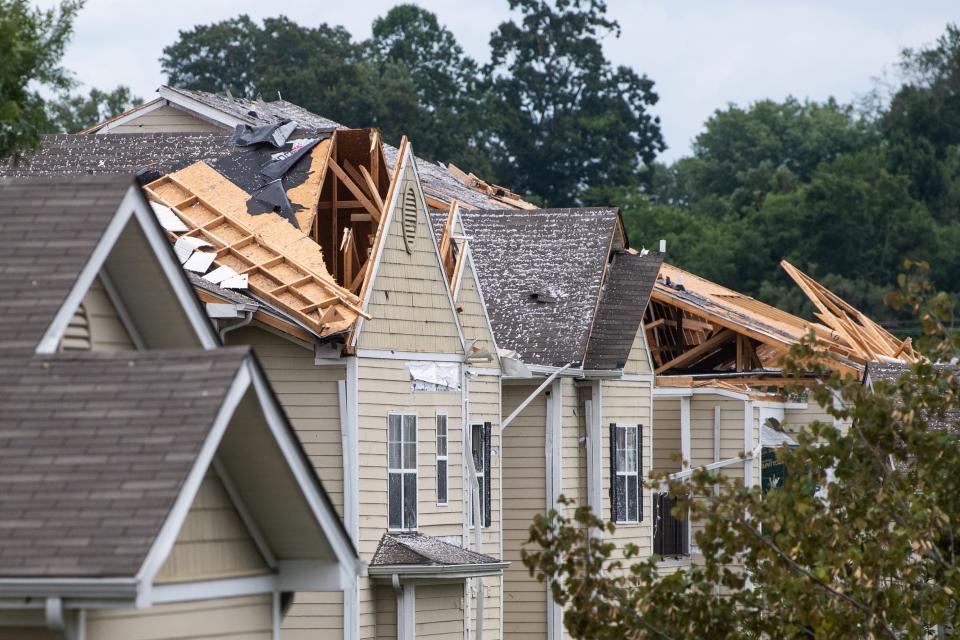Why wasn't there a tornado warning this week? Here's why the storm was so unusual
The 3-mile-long EF2 tornado that caused severe damage to the Lovell Crossing Apartments and Lovell Cove this week was out of the ordinary for several reasons.
One is that an August storm of that magnitude is rare for East Tennessee. Another is that it developed in a way that didn't give meteorologists time to issue warn that a tornado was forming.
The National Weather Service office in Morristown had issued a tornado watch for the region that day, but not a more serious warning. No one died in the storm, though it ripped out decades-old trees, tore off roofs and downed dozens of power lines across the area.
A tornado watch means tornadoes could develop in an approaching storm, while a tornado warning means residents should take shelter immediately because a tornado has been sighted in person or on radar.
The Aug. 7 storms looked like they would bring more straight-line wind versus a tornado, said Anthony Cavallucci, a warning coordination meteorologist at National Weather Service. "These storms weren't super cell storms, meaning storms that have rotating updrafts. ... This was several lines of thunderstorms with a signature that usually means strong winds."
The strong straight-line thunderstorm winds produced a "bow echo," a system shaped like an archer's bow, Cavallucci said.
"It just so happened to be a circulation on the north side of that line that spawned that strong EF2 tornado in West Knoxville," he said. "The majority of the storms were not exhibiting rotation, but this one did. ... About four to five minutes of rotation that was detectable by radar before it fell apart."
The storm was just the seventh August tornado in the region since the weather service began keeping modern records in 1950. It was the only tornado to hit Knox County in August.
The meteorologist said several severe thunderstorm warnings were issued, which mean wind speeds of 58 miles per hour or stronger and/or 1-inch hail.
"It is pretty unusual to be under a tornado watch in August in East Tennessee," Cavallucci said. "That should have been a clue that something was a lot different from normal."
Weather service uses a spotter system in addition to radar
The National Weather Service uses Doppler radar and a spotter system to determine when to issue warnings, Cavallucci said.
He said Knox County has 387 spotter volunteers in the weather service's database, who are activated during a storm watch. It also uses information relayed by amateur radio operators, he said.
On Aug. 7, the "rain-wrapped tornado" escaped detection.
"The rainfall and wind was so heavy, you couldn’t see anything," Cavallucci said. "So we didn’t get a single spotter report of the tornado. The amateur radio operators, they relayed information to us in real time (but) we got mostly damage reports, after the fact."
Why doesn't Knox County or Knoxville have tornado warning sirens?
Outdoor community sirens aren't considered to be the best ways to send out tornado warnings.
"Sirens have some notable limitations and they’re not the most efficient or cost-effective way of warning the community," said Colin Ickes, the director of the Knoxville-Knox County Emergency Management Agency. "Sirens are limited in their effectiveness since they are intended only to warn people who are outdoors. If you live very close to a siren, you may be able to hear it inside, but even if you’re close, it’s unlikely that you’ll hear it if you are watching TV, listening to music or sleeping."
Outdoor sirens aren't nuanced or informative, Ickes added.
"They serve as a 'tap on the shoulder' to get attention and warn people that there is a problem, but then it’s up to them to know what to do or to seek additional information about the emergency," he said.
Sirens typically cost between $30,000 and $50,000 each to install, Ickes said, adding the total cost in Knox County would likely be somewhere between $6 million and $12 million initially, plus ongoing maintenance and operating expenses.
While Knox County never had a tornado siren system, it did have air raid sirens installed in the 1950s.
Justin Birchfiel, who has saved and restored a Knoxville Thunderbolt air raid siren from Prosser and Buffat Mill roads, has said only three sirens remain from the Cold War era system that was dismantled in the 1980s. The Tennessee Siren Enthusiasts Group has been trying to obtain and restore them, potentially for use as a tornado warning system.
What's the best way to keep yourself up to date during emergencies?
Ickes recommended residents purchase digital weather radios, which are relatively inexpensive devices. The radios can relay watches and warnings from the National Weather Service, as well as information such as Amber Alerts from police. Users can set them to receive notices specific to a certain county or agency.
If you prefer a mobile-friendly alternative, the Knox County Commission has established an emergency warning system that sends alerts by text, email or voice phone call. Users can choose the locations for alerts, such as a home or work address.
"The system will automatically relay warnings from the National Weather Service for things like tornado warnings or severe thunderstorm warnings and it can also be used by Knox 911 to send warning messages for things like hazardous materials emergencies or active shooter incidents," Ickes said.
To register for the emergency warning service, sign up for the system by going to https://knoxcounty.org/alert/index.php. You can also sign up by calling 311 or 865-215-4311.
Liz Kellar is a public safety reporter. Email lkellar@knoxnews.com.
Support strong local journalism by subscribing at knoxnews.com/subscribe.

This article originally appeared on Knoxville News Sentinel: Knox County tornado had no warning. Here's why it was unusual

